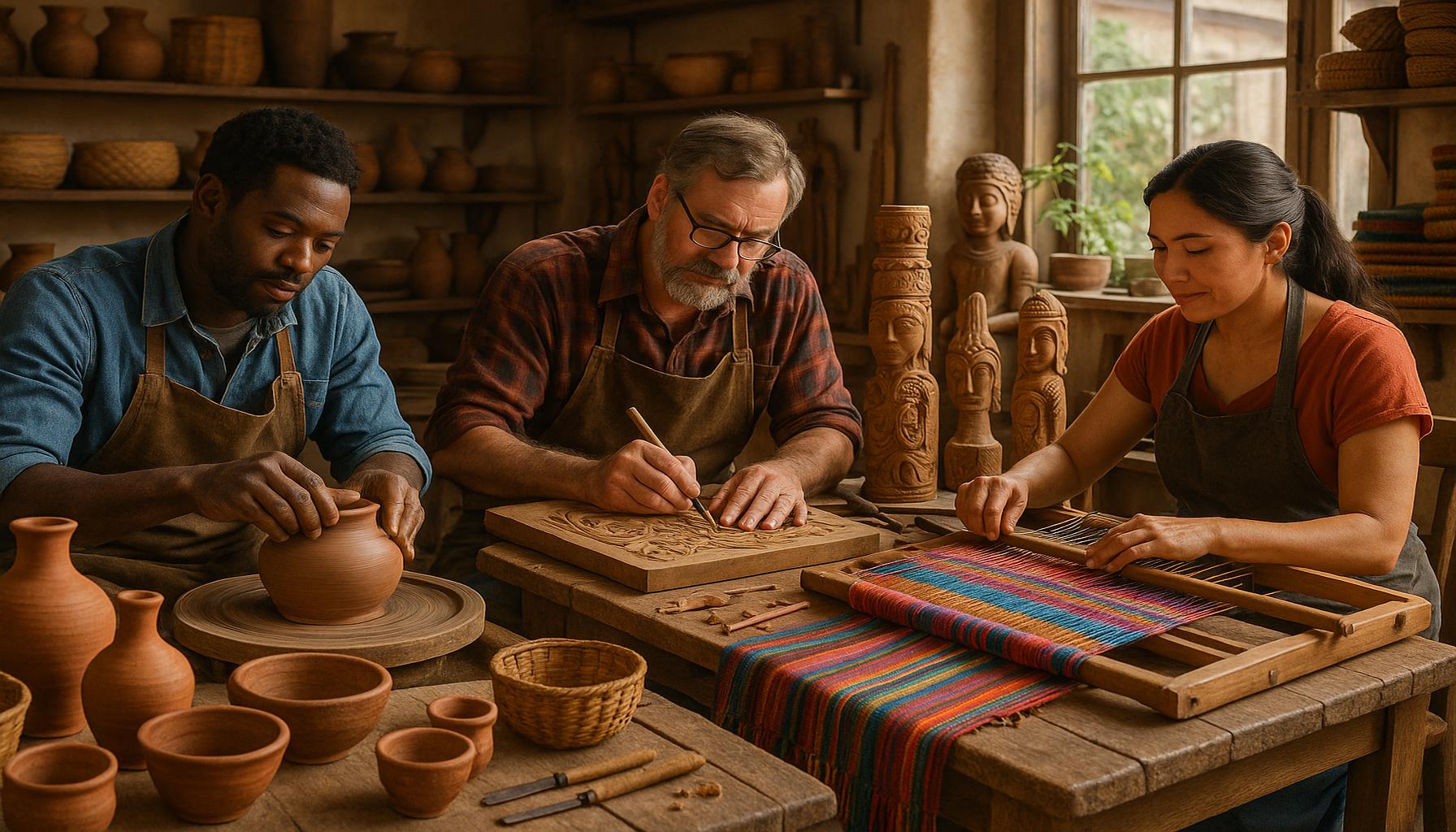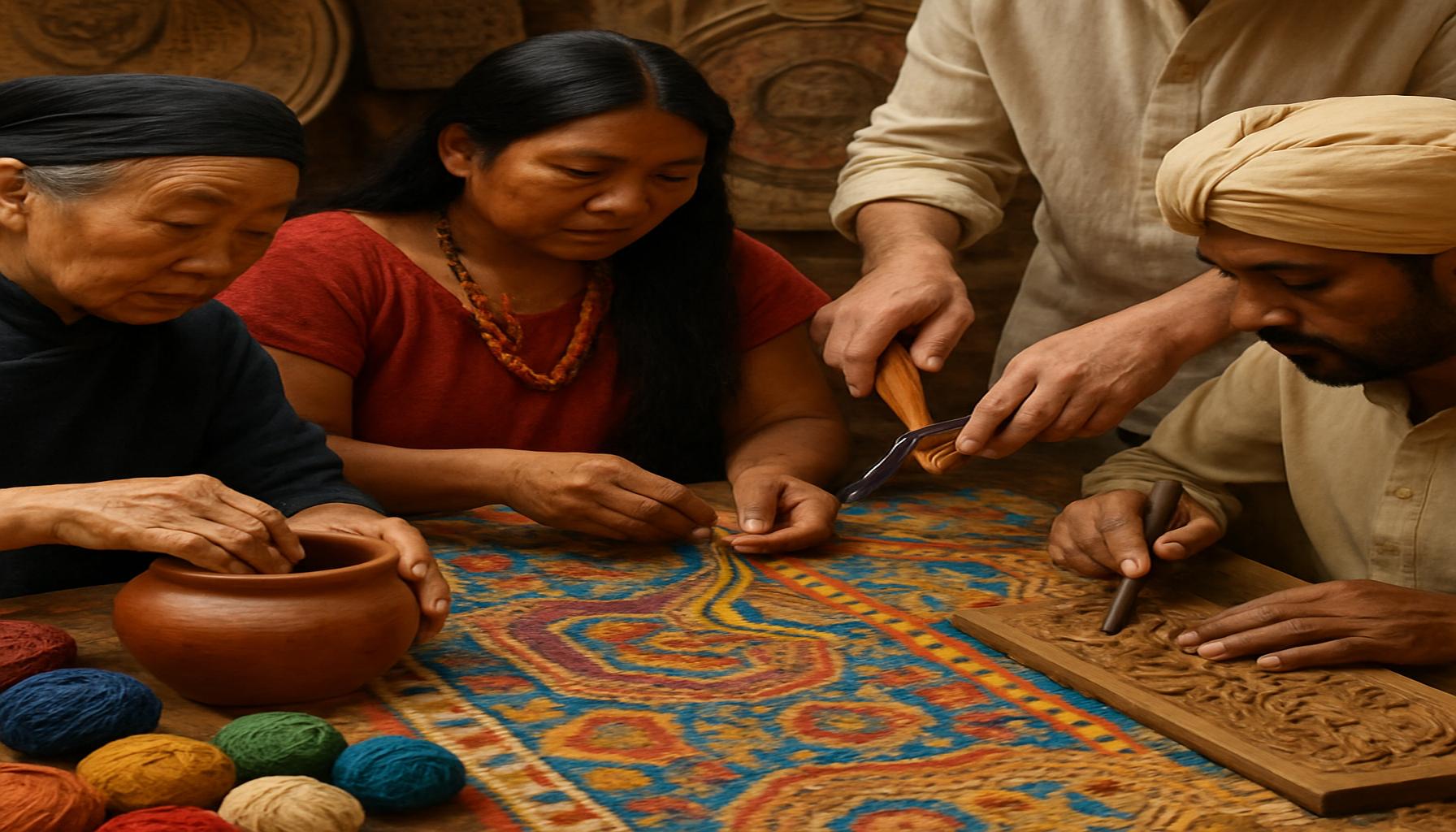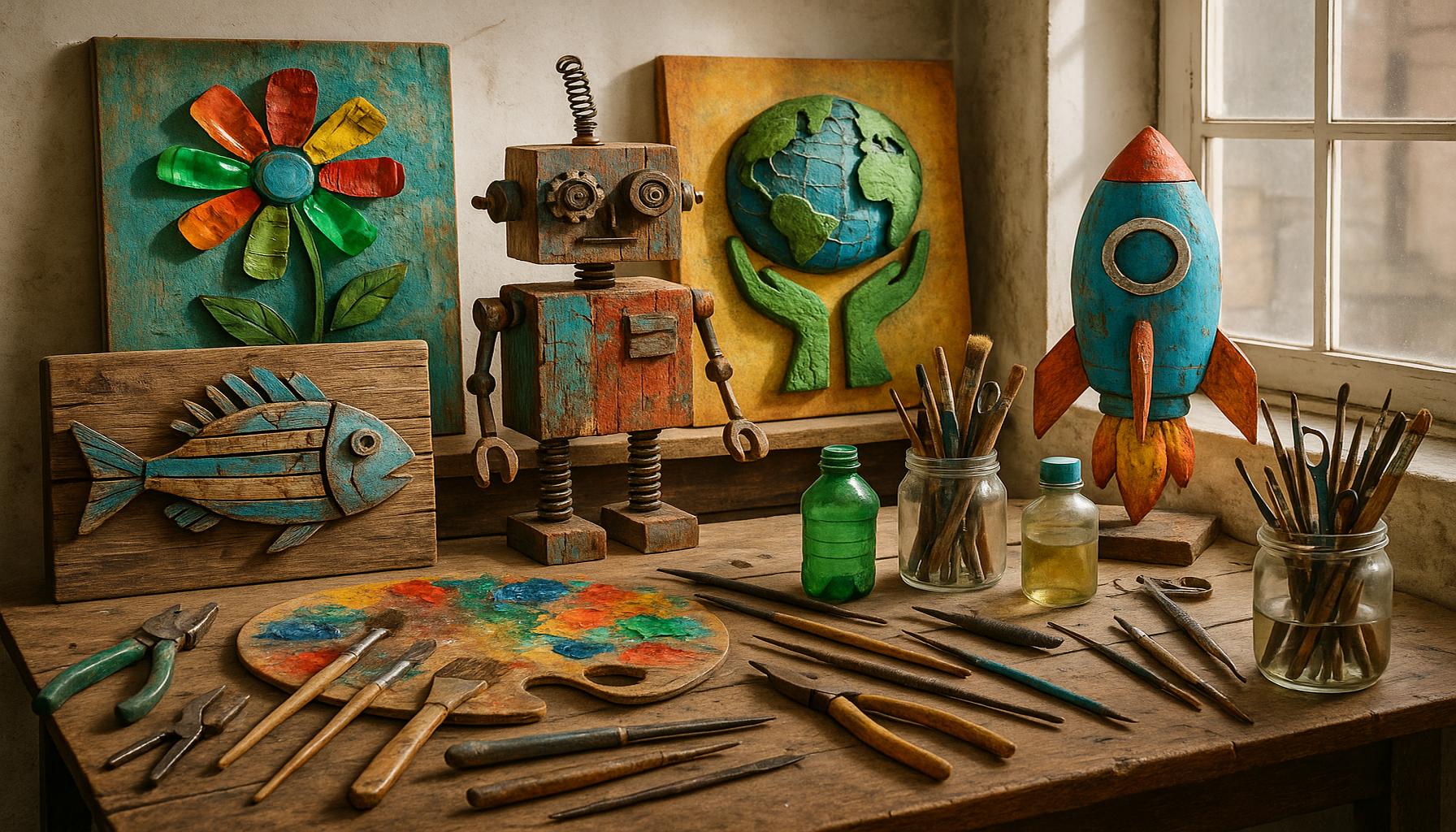The Crafting Community: How Local Groups are Fostering Connections and Creative Collaborations

The Crafting Community: A Source of Connection and Growth
In today’s fast-paced digital world, the crafting community stands out as a vibrant network of individuals united by their passion for creativity. Local groups are emerging as nurturing grounds where crafters of all levels come together to share skills, knowledge, and inspiration. With the rise of social media, platforms like Instagram and Pinterest have popularized various craft movements, but the tangible experience of connecting with others in person adds a unique dimension to the crafting experience.
These groups play a vital role in fostering connections and building lasting relationships. By participating in crafting communities, members often experience benefits such as:
- Skill Development: Workshops and hands-on classes offer opportunities to learn new techniques, whether it’s knitting, pottery, or digital design. For example, many local yarn shops host “knit nights” where crafters can learn new stitches while enjoying the camaraderie of fellow knitters.
- Social Engagement: Craft meet-ups alleviate isolation by bringing individuals together for collaboration. Many cities now feature crafting gatherings where participants can work on projects, share their progress, and exchange tips, effectively turning a solitary activity into a social occasion.
- Cultural Exchange: Crafters explore diverse artistic traditions, enhancing their creative perspectives. Local groups often celebrate various cultural events, inviting members to share crafts that reflect their heritage, such as traditional quilting patterns or ethnic beadwork.
The influence of local crafting groups extends beyond individual enrichment. They also contribute to community well-being by:
- Supporting Local Economies: Craft fairs and exhibitions showcase local artisans, driving consumer support for handmade goods. Events like farmer’s markets often include spaces for crafters to sell their work, allowing small businesses to flourish.
- Strengthening Community Bonds: Collaborative projects unite neighborhoods around shared goals. For instance, community mural projects involve crafters and non-crafters alike, fostering pride and ownership of local spaces.
- Encouraging Sustainability: Many groups focus on eco-friendly practices and upcycling initiatives. Sewing circles that repurpose old fabrics into new creations not only promote recycling but also instill a sense of responsibility towards the environment.
This dynamic environment not only nurtures creativity but also cultivates lasting friendships. Through shared experiences and support, members often find themselves forming deep and meaningful connections. As we delve deeper into how these local groups are making a significant impact, prepare to discover the transformative power of connection through crafting. From shared knowledge and the creation of beautiful works to the empowerment of communities, crafting is not just a hobby; it is a bridge to enriched lives and connected communities.
DIVE DEEPER: Click here to discover sustainable crafting
Empowering Creativity Through Collective Efforts
The unique appeal of local crafting groups lies in their ability to connect individuals from diverse backgrounds, effectively fostering a sense of belonging and collaboration. These communities act as incubators for creativity, providing an environment where ideas can flourish and members can propose, practice, and perfect their crafts together.
Crafters come together not just for the experience of creating but also for the shared joy of learning from one another. Workshops and classes provide an excellent framework for building skills and expanding horizons. In many communities across the United States, local crafting groups host regular events that cater to various interests. For instance, **community sewing circles in Portland** focus on everything from beginner stitches to advanced quilting techniques, often taught by seasoned members who are passionate about sharing their knowledge. This hands-on engagement cultivates a strong sense of mentorship and community.
Moreover, social engagement is a significant benefit of participating in these groups. With the increasing focus on mental health and well-being, crafting gatherings are becoming a vital alternative to solitary activities. Craft fairs, open studio nights, and themed crafting sessions provide an opportunity for individuals to alleviate isolation while connecting over shared interests. These gatherings can transform a simple art project into a collective experience that enriches lives. Take the example of **knit-alongs in New York City**, where knitters gather to work collectively on intricate patterns, sharing tips and encouraging one another through the process.
An Exchange of Cultures and Creativity
The crafting community also serves as a diverse platform that promotes cultural exchange. Many local groups make a concerted effort to incorporate traditional crafts from various cultures into their offerings. This not only enriches the skillset of members but also raises awareness and appreciation for different creative practices. For instance, during **Mardi Gras in New Orleans**, local crafting groups often set up workshops that teach attendees how to make traditional masks and costumes, blending artistry with local culture.
This cultural celebration through crafting invites crafters to explore different methods and traditions, enhancing their creative perspectives while building a deeper connection to one another. The unity formed through such exchanges often leads to richer collaborative projects, where members contribute their unique skills to create something that celebrates their diversity.
Community crafting initiatives are not just about art; they are also about empowerment and sustainability. Many groups focus on eco-friendly practices by incorporating upcycling into their projects. Events where participants transform old textiles or household items into fashionable accessories not only showcase creativity but also promote a responsible approach to consumption and waste management.
As we explore the various avenues through which local crafting groups connect individuals, it becomes evident that these communities are not merely hobbies; they are transformative spaces that celebrate creativity, build friendships, and promote personal and community well-being.
As the crafting community continues to grow, local groups play a vital role in enhancing connections and encouraging collaboration among individuals. These grassroots organizations serve as hubs where creativity flourishes, providing a platform for members to share skills, ideas, and resources. By gathering in supportive environments, crafters can exchange knowledge, learn new techniques, and inspire one another.One significant advantage of local crafting groups is their ability to cater to a diverse range of interests. From knitting and quilting to woodworking and pottery, these communities provide a wide spectrum of opportunities for individuals to explore their passions. This diversity not only enriches the crafting experience but also attracts people from various backgrounds, leading to a vibrant mix of perspectives. Consequently, local groups become not just a space for skill-sharing but also a cultural melting pot, fostering innovation through collaborative projects.Moreover, these groups often organize workshops, craft fairs, and exhibitions that empower members to showcase their work. Such events not only help in building confidence among crafters but also create economic opportunities. By selling their handmade goods or demonstrating their craft, local artisans can cultivate their brands, gain visibility, and connect with potential clients. Additionally, these gatherings foster social bonds, making the process of crafting a collective experience that extends beyond individual projects.The impact of local crafting groups is evident in their ability to foster mental well-being. Engaging in creative activities has been shown to reduce stress and improve emotional health. Crafting alongside others cultivates a sense of belonging; when individuals come together with shared interests, they form networks of support that can be invaluable for personal growth and community enhancement.Through the power of collaboration, these local groups not only invigorate individual creativity but also contribute to the revitalization of local economies and social cohesion. By nurturing talents and providing a stage for creative expression, the crafting community exemplifies the profound effect of shared interests in building connections and fostering long-term collaborations.
DIVE DEEPER: Click here to uncover the evolution of digital photography
Building Bridges Through Shared Passion
Local crafting groups play an integral role in establishing connections that extend beyond the mere act of creation. In many cases, these communities serve as lifelines for individuals seeking camaraderie and inspiration. Crafting clubs, like those found in cities such as Austin and Minneapolis, often host potlucks and social evenings that combine the art of crafting with community engagement, making them perfect venues for friendships to blossom. Here, members exchange not only skills but also stories, allowing personal relationships to deepen over the shared experience of crafting.
In addition to nurturing individual connections, crafting groups have also emerged as centers for collaboration among local artisans and small businesses. Many groups partner with local shops to create promotional events, hosting mini-expos that showcase handmade goods and allowing local artists to gain visibility in their communities. For instance, the Grand Rapids craft community collaborates with local breweries for “Craft and Draft” nights, where participants engage in crafting while enjoying locally brewed beverages, blending creativity and local business support. These types of events not only generate a sense of unity but cultivate an environment ripe for creative partnerships.
Social Media: A Modern Crafting Revolution
In the digital age, local crafting communities are also harnessing the power of social media to amplify their reach and connect with a broader audience. Platforms like Instagram and Facebook have become crucial tools for these groups to share their projects, promote events, and celebrate the achievements of their members. Hashtags such as #CraftingCommunity and #HandmadeWithLove have created virtual spaces for crafters to find one another and exchange ideas, sometimes leading to in-person meetups and collaborations.
Moreover, online marketplaces, such as Etsy, have allowed local artisans to showcase their work to a global audience. Many crafting groups utilize these platforms to establish group shops, where members can collectively sell their creations, thereby boosting individual revenues while strengthening community bonds. Noteworthy is the rise of challenges or collaborative projects fostered through these channels, where groups collectively set out to create and share a specific piece, harnessing their individual talents toward a common goal.
Additionally, nonprofits and charitable organizations have recognized the potential of crafting groups in community outreach. Numerous groups engage in social crafting events, where members create items for charitable causes, from blankets for homeless shelters to chemo care bags for cancer patients. Such initiatives serve a dual purpose: they enhance the crafting experience by contributing to society while fostering connections rooted in altruism. For example, organizations like Project Linus provide opportunities for crafters to donate handmade blankets to children in need, forging bonds between members who engage in this meaningful work.
The Future of Community Crafting
The crafting community is poised for growth, with an increasing number of people seeking meaningful connections and a sense of purpose through creative expression. As interest in sustainable living and local production rises, more individuals gravitate towards crafting as a means to connect with their environment, their cultures, and their communities. Local crafting groups are thus positioned to play an even more pivotal role in fostering creativity and collaboration, acting as microcosms of resilience and innovation.
In essence, the craft movement is far from a solitary endeavor; it is a vibrant synergy of talents, traditions, and newfound friendships. As local crafting groups continue to evolve, they remain at the forefront of nurturing an ever-expanding web of creativity, connection, and community engagement.
DISCOVER MORE: Click here to dive deeper
Embracing the Spirit of Collaboration and Connection
In conclusion, the crafting community stands as a testament to the power of human connection and creativity. Through local groups, individuals not only find a place to hone their skills but also forge lasting friendships and meaningful collaborations. As we have explored, these groups serve as vital hubs for community engagement, where shared passions lead to support for local artisans and small businesses, further enhancing cultural ties.
The impact of social media cannot be overstated, as platforms like Instagram and Facebook have revolutionized the way crafters connect and collaborate, bridging local and global communities. Additionally, the emergence of online marketplaces such as Etsy has provided an avenue for artisans to showcase their talents beyond their neighborhoods, promoting sustainability while uniting creative spirits.
Furthermore, the altruistic initiatives driven by crafting groups highlight how creativity can contribute to social good, fostering connections that extend beyond personal fulfillment. Whether participating in charity drives or creating handmade items for those in need, these projects reinforce the importance of community and compassion.
As we look to the future, the crafting community is likely to expand further, continuing to attract those seeking connection, purpose, and creativity. With each stitch, brush stroke, or knot tied, crafters are not just creating beautiful pieces; they are weaving the fabric of their communities, one connection at a time. It is clear that the soul of crafting lies in collaboration, and in this vibrant movement, individuals will continue to find strength, support, and shared joy.


